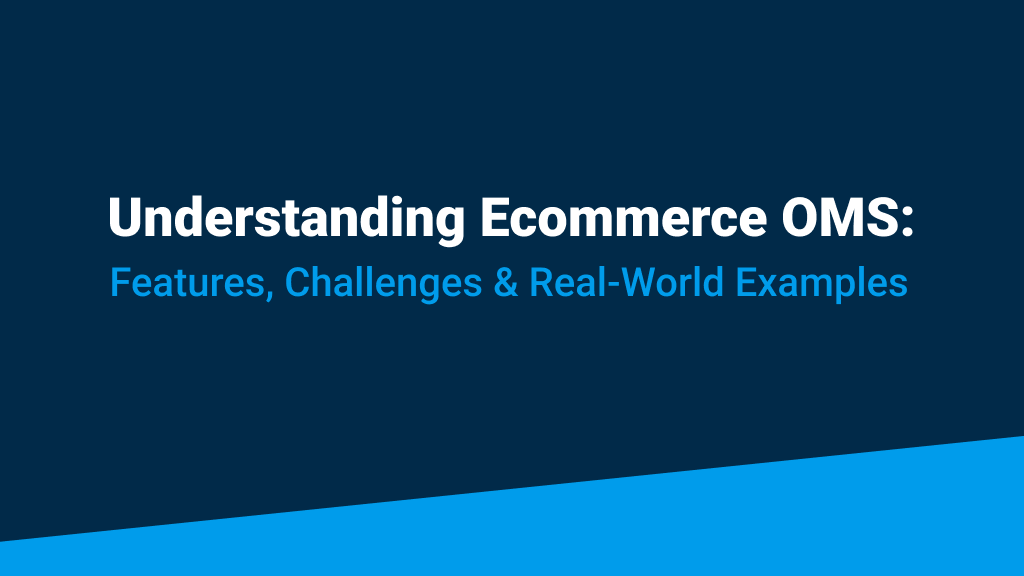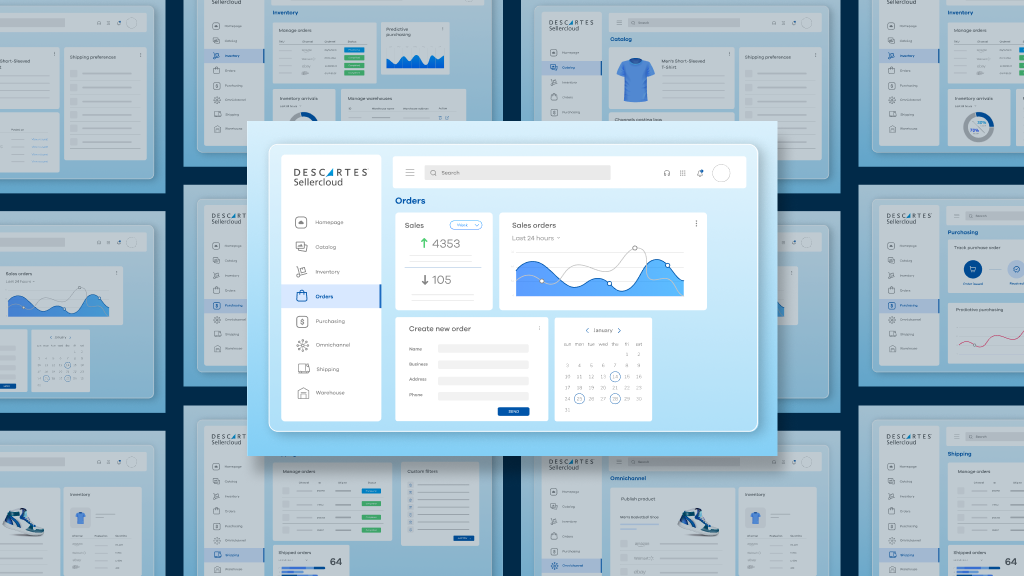
Key Points
- An ecommerce OMS is an order management system designed specifically for businesses that sell products online.
- An ecommerce OMS helps sellers consolidate orders to one platform, track orders, synchronize inventory, generate reports, and much more. Its biggest benefit is that it reduces the time businesses spend managing orders.
- A good ecommerce order management system should reduce time spent fulfilling orders, reduce manual overhead, offer plenty of integrations, help with inventory forecasting, and help manage backorders and returns.
- Hundreds of companies, including R&Y AC Compressors, CPGIO, and THINKCAR, have solved their order management challenges with Descartes Sellercloud’s OMS features.
Order management is one of the most crucial aspects of running an ecommerce business. If you cannot ship orders to customers promptly, without issues, your business will not survive. Early on, a young ecommerce business with low order volume might be able to get by managing orders on pen and paper or a spreadsheet, but as that company grows, it will need something more advanced.
In this article, we’ll define what an ecommerce OMS is, explain some of the common challenges before using an OMS, and list some real-world examples where an OMS helped an ecommerce business defeat its order management challenges.
What Is an OMS in Ecommerce?
An OMS centralizes and automates the order lifecycle from the moment a purchase is made to fulfillment. An ‘ecommerce OMS’ is designed specifically for ecommerce businesses to fulfill and track their orders. However, not all ecommerce OMSs are the same. Ecommerce businesses should use systems designed specifically for their needs and workflows.
Industries like pharmaceuticals, food and beverage, wholesale, and digital goods also use OMSs to manage their orders. While these businesses can have some overlap or fall under the umbrella of ecommerce, they have unique requirements like compliance, expiration tracking, or LOT code management that a business selling clothing, for example, might not need.
An ecommerce-focused OMS addresses these complexities with tailored features that improve efficiency, accuracy, and customer experience. Using an OMS not tailored for ecommerce can potentially lead to inefficiencies, like order delays or inventory mismatches, especially when managing multiple sales channels.
Are you new to order management? Read our order management guide and learn all there is to know about best practices and order management systems.
What Are Common Challenges Before Using an Ecommerce OMS?
Before adopting a purpose-built ecommerce OMS, businesses can face operational bottlenecks limiting growth and efficiency. Manually processing orders can be enormously challenging and time consuming. Some of the most significant challenges of operating a business without an ecommerce OMS include:
- Orders not fulfilled on time.
- Incorrect orders being shipped.
- Orders getting lost or forgotten.
- Unable to prioritize orders based on urgency.
- Not being able to track orders.
- Unable to reduce and manage backorders.
- Missed order service level agreements (SLAs).
- No available inventory synchronization.
- Unable to produce reports.
- Unable to fulfill orders from different warehouses and locations.
- No return, refund, or exchange workflow.
The above challenges can mean hours are lost on tasks unrelated to processing incoming orders. With an OMS at the center of managing these tasks, you process more orders faster, which is vital for growth, and simultaneously reduces human error.
Even if an ecommerce business is using an OMS, if it is not suited to their needs, these challenges can persist. They may be lacking the flexibility and features they need to manage operations that are specific to their industry and business model.
Warehouse and shipping tasks should also be considered. While not always included with an OMS, businesses may struggle without a system to help manage their warehouse and shipping operations. Alternatively, they may have separate solutions for warehouse and shipping tasks, but they might not integrate well, which can cause various problems.
How Can an OMS Help an Ecommerce Business?

Making an ecommerce OMS the center of your order fulfillment workflows can lead to enormous improvements in efficiency. Here are some real-world examples of how ecommerce businesses have overcome their order management challenges with Descartes Sellercloud’s OMS.
Example 1: R&Y AC Compressors
R&Y AC Compressors is a private-label manufacturer producing automotive AC compressors, condensers, and dryers. The business was overwhelmed with a high volume of daily orders, processing hundreds daily. If orders weren’t shipped by the end of the day, they’d have to wait until tomorrow.
By the end of the week, the number of orders would pile up, and they would need to make changes to the store because they couldn’t manage the order volume. They needed an order management solution to help prioritize how and when to fulfill their orders, save time sorting and picking orders, and get orders shipped more efficiently.
Descartes Sellercloud boosted R&Y’s order management efficiency by automatically assigning orders to different teams every morning. Now R&Y saves three to five hours a day, processes an additional 200 to 300 orders daily, and orders no longer pile up at the end of the week.
Read the whole customer success story here.
Example 2: CPGIO
CPGIO is a 3PL business that also provides distribution and marketing services. Some of the brands CPGIO works with include Kraft Heinz, Campbell’s, Nestlé, SC Johnson, Rubbermaid, and Newell. CPGIO had outgrown its current system, which was only built to manage orders from one channel, and it did not provide useful reports.
CPGIO implemented Descartes Sellercloud to have a central point for all channels and orders, and solved a wealth of other challenges too. Using Descartes Sellercloud’s open API, they connected their reporting, shipping, and other solutions. They also utilize the Order Rule Engine, which allows them to set up rules for specific actions, such as flagging potentially fraudulent orders.
Since making Descartes Sellercloud its order management system, CPGIO has almost doubled its channels and increased the capacity of orders it can manage with the same team.
Read the whole customer success story here.
Example 3: THINKCAR
THINKCAR is a vehicle diagnostics technology company that manufactures professional vehicle scanners for auto body shops and technicians. New to ecommerce, they relied on a complex system of Google Sheets to track inventory and processed most orders via email. Orders would fall through the cracks, and fulfillment would sometimes be missed.
Descartes Sellercloud centralized THINKCAR’s warehouse, inventory, order tracking, sales, and customer service into one system. Now orders are processed as they arrive, regardless of channel or marketplace. Descartes Sellercloud aggregates the data from every marketplace they sell to ensure that the inventory stays accurate and that orders are fulfilled quickly and efficiently.
Read the whole customer success story here.
What Features Should the Best Ecommerce Order Management System Include?
What features your ecommerce OMS should include depends on what you are selling, your tech stack, and your business goals. Your budget should also be considered as OMS features and pricing can vary significantly (and that doesn’t always indicate quality).
Here are some of the most crucial features to consider when looking for the best ecommerce order management system for your business:
- Order orchestration. The most important thing an ecommerce OMS should do is allow you to manage orders. It should allow you to filter, follow up, and prioritize orders at the very least.
- Integrations. It should offer all the integrations your business currently uses. Even better, it would be ideal if it offered integrations that you might need as your business grows and the ability to request custom integrations.
- Backorder functionality. If an ordered product is not currently available, the OMS should create a backorder that can be fulfilled as soon as the product is in stock.
- Forecasting. Your chosen OMS should be able to use historical sales data to forecast how much to order for the upcoming period.
- Automations. Is your chosen OMS advanced enough to allow you to create automations and schedule tasks to further reduce manual work?
- Inventory, warehouse, and shipping modules. Can you manage your inventory, warehouse, and shipping tasks all from one interface, or do you need to integrate with additional solutions?
- Returns management. The OMS should be able to manage returns, refunds, and exchanges efficiently.
- Customization. Can you customize your OMS to work how you need it? Some solutions resist feedback or charge extra for needed adjustments, leaving businesses stuck with rigid tools.
- User experience. Is your chosen OMS free of clunky interfaces and poor navigation that can slow down teams and increase training time?
Why Descartes Sellercloud Is the Best OMS for Ecommerce, Regardless of Product Niche

Descartes Sellercloud’s OMS features conquer all the order management challenges listed above and provide the vital features an ecommerce business needs not only to survive but succeed and grow without needing to expand the team. It enables businesses to reclaim hours of manual work, reduce order errors, and increase order fulfillment efficiency at an affordable price.
What’s more, Descartes Sellercloud includes a powerful WMS module, Skustack, to help you manage your warehouse and a shipping module, Shipbridge, to help you get the best shipping rates for your orders.
Find out more about Descartes Sellercloud’s modules here.
The examples speak for themselves—R&Y AC Compressors, CPGIO, THINKCAR, and many other ecommerce businesses were able to put an end to their order management challenges with Descartes Sellercloud. Watch the video below to hear from more businesses that are thriving after deploying our ecommerce OMS.
Book a Descartes Sellercloud demo today to discover how we can solve your ecommerce order management challenges.




